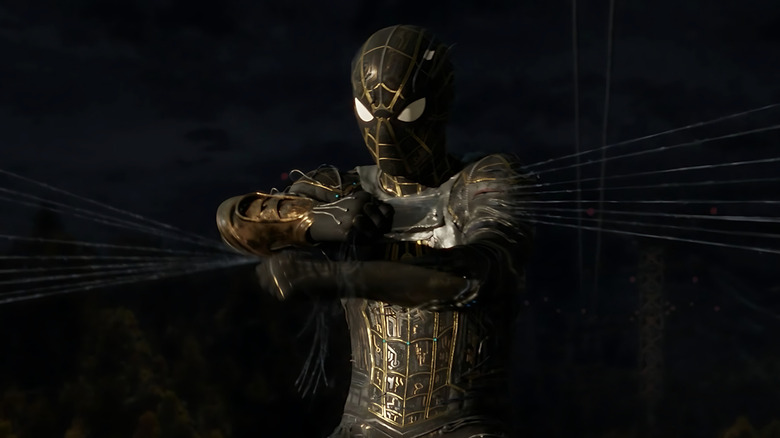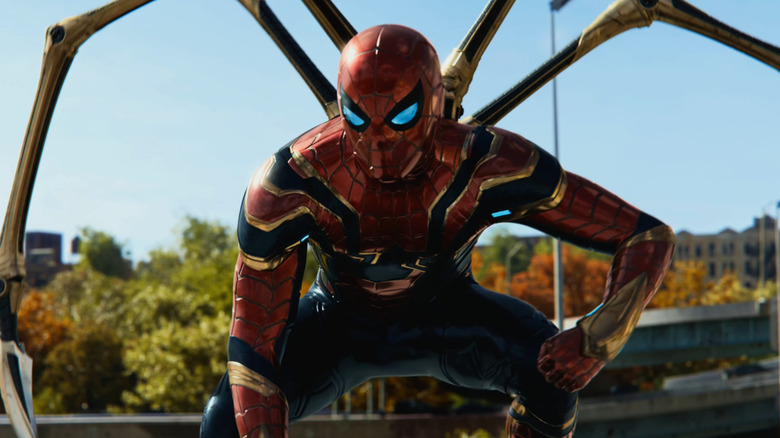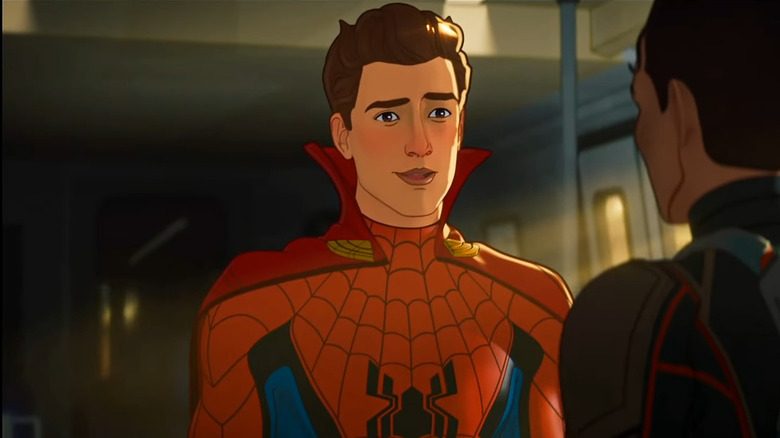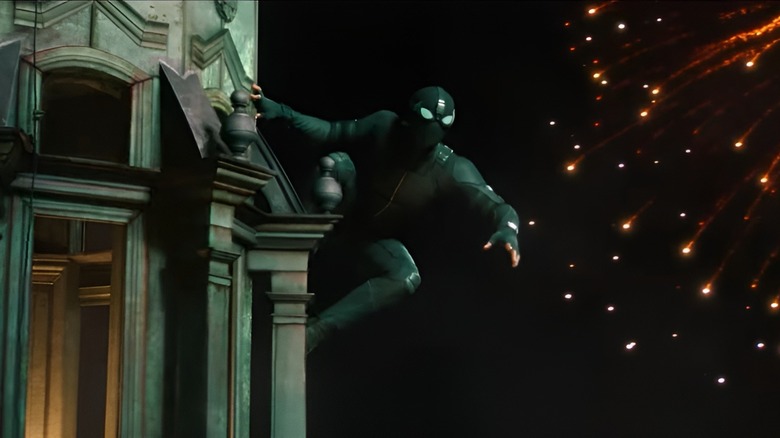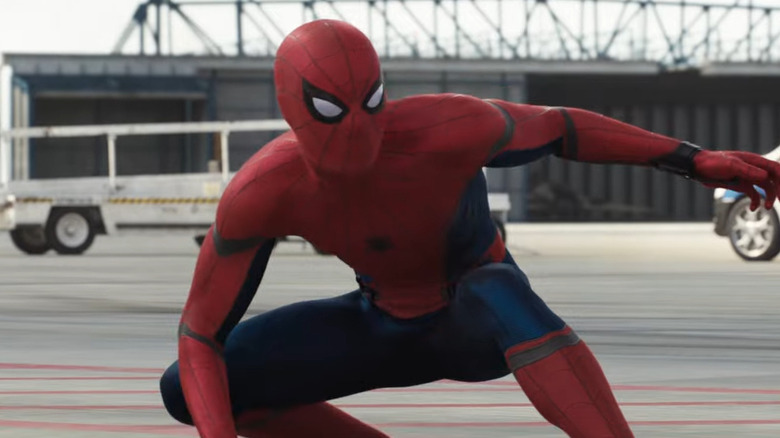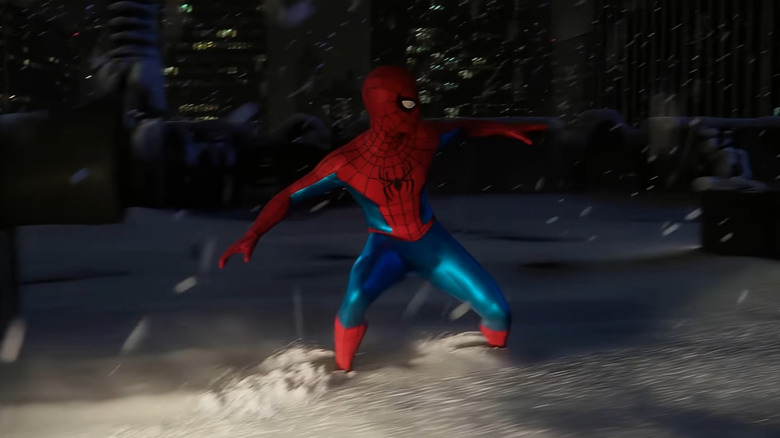All 10 Tom Holland MCU Spider-Man Suits, Ranked
It's a "Brand New Day" in the Marvel Cinematic Universe, as Tom Holland and "Shang Chi and the Legend of the Ten Rings" director Destin Daniel Cretton are set to bring Spider-Man back to the franchise in a big way. Though production temporarily paused so that Holland (who has played the character since 2016, when he made his MCU debut in "Captain America: Civil War") could recover from injuries sustained on set, positive reports about his health as of writing seem to indicate the film will still reach theaters in the summer of 2026.
Buzz has been overwhelmingly positive for Holland's fourth "Spider-Man" feature with Sony Pictures and Marvel Studios, with fans going absolutely buggy over official set photos of the actor sporting a stylish new costume. Cretton's predecessor Jon Watts used Peter Parker's many Spidey-suits intentionally throughout his "Homecoming" trilogy, often as symbols of the character's journey from vigilante to Avenger to friendly neighborhood hero. Amidst all this excitement, we've taken a peek through Peter's wardrobe in the MCU so far, ranking every Spider-Man costume based on their individual design and narrative impact.
Black and Gold, Inside and Out (Spider-Man: No Way Home)
There isn't necessarily anything bad about the Black and Gold suit, which Peter wears briefly in "Spider-Man: No Way Home." The 2021 film was a celebration of the "Spider-Man" legacy on film, featuring no less than seven different Spidey-suits throughout its runtime — five of which were worn by Tom Holland. Of the bunch, this suit is visually interesting at first glance, but it gradually loses its luster the more it's on screen — it also doesn't help its case that it's generous to consider the Black and Gold suit its own entity at all, given that it's actually just another Spidey-suit turned inside out.
In the aftermath of Quentin Beck / Mysterio's (Jake Gyllenhaal) fabricated video that unmasked Peter Parker and painted him as a cold-blooded killer, Parker is literally painted by one of Mysterio's devotees while walking down the street. It's possible the green paint that stains the outside of this suit (which calls to mind a primary color of Mysterio's costume, as well as the bright green used in VFX backgrounds) is meant to symbolize how the villain stained his reputation, forcing him to literally and metaphorically turn his identity inside out.
Thematic interpretations aside, the exposed, fraying wires and smartphone duct-taped to his chest don't make for an aesthetically pleasing look outside of concept art. The suit is also only used in a dark nighttime sequence which barely gives the audience the necessary screentime or lighting to appreciate its better qualities (it also can't help but feel like the film missed a trick by not having the suit somehow be uniquely defensive against Jamie Foxx's Electro, a character in the comics who often necessitates a specialty, one-off suit not unlike this one).
The Iron Spider (Avengers: Infinity War/Endgame, Spider-Man: No Way Home)
Most of the Spidey-suits seen in the MCU have some degree of post-production, CGI clean-up applied to them. (This seems largely to be an attempt to capture the iconic Spider-Man silhouette from the comics, with a suit so skin-tight it essentially — and unrealistically — moves like flesh itself, the fabric almost never wrinkling or bunching as a physical costume would.) It's easy to forgive and forget this fact for the majority of the character's appearances in the series, but the Iron Spider costume is so uncanny and obviously animated that it not only borders on distracting, but — especially in "Avengers: Infinity War" and "Endgame" — often makes the character feel like an entirely computer-generated asset added in post. Granted, it's hard to imagine a practical way for Marvel Studios to recreate one of the strongest versions of Spider-Man from the comics, but we're just glad this suit is used more smartly and sparingly in the character's solo outing.
It's also worth mentioning the conflicting symbolic use of the costume in Peter's story arc. There had been ideas to introduce the Iron Spider suit as early as "Captain America: Civil War," but the suit is ultimately first seen at the end of "Spider-Man: Homecoming" as something of a signing bonus for Peter joining the Avengers. While the suit does continue to consistently represent Peter entering into a much larger world with a more high-profile identity that doesn't quite square with the friendly neighborhood hero he sees himself as (Peter initially turns down the suit in "Homecoming," pointedly leaves it in the U.S. in "Spider-Man: Far From Home," and loses it entirely in "Spider-Man: No Way Home"), the back and forth between keeping and losing it borders on wishy-washy.
Peter Parker, Zombie Hunter (Marvel's What If...?)
Of all the looks we've seen from Spider-Man since his introduction into the MCU, we'd argue his most overlooked is his animated design from "What If...?" This is likely because it's largely dismissed as an animated translation of his most common MCU suit — and while that's technically true in terms of its storytelling value, the design of it is different enough to note here.
Don't get us wrong — we love the original Stark Suit this look is based on (as readers may have noticed, it hasn't yet appeared on this list). But if there's one fair complaint that could be lodged at the costume that helped define the modern look of Spider-Man on film, it's that it's a little muted in its valiant attempts to fit in with the rest of the Avengers ensemble. The webbing is much thinner than any previous Spider-Man costume and the central front spider emblem is small enough that it barely draws the eye, even when you see it for the first time (without looking, we bet you'd have an easier time drawing the Tobey Maguire or Andrew Garfield Spider-Man logos than you would Tom Holland's). This doesn't make the suit bad by any means, just very different from the sort of Spidey-suit fans had come to expect.
The "What If...?" suit (featured prominently in the season 1 episode "What If... Zombies?!") achieves a happy medium between the MCU look and more traditional designs. The front spider is much larger, taking up most of the hero's chest space, and all the black detailing pops in a satisfying way — including the slightly thicker webbing. It works well for an animated series, and the orphaned cape of Doctor Strange even serves as a surprisingly decent tactical accessory.
SHIELD Tactical Stealth Suit (Spider-Man: Far From Home)
Speaking of Peter Parker's perfectly pleasant vacation from the madness of the post-"Endgame" MCU, "Spider-Man: Far From Home" is the best example of Jon Watts using the wall-crawler's wardrobe as a means of communicating the character's journey through another medium. As we alluded to in the previous section, Peter begins the movie struggling to accept his new role as a universe-saving Avenger after the death of Tony Stark (Robert Downey Jr.) in "Avengers: Endgame." Though it's seemingly established that his permanent crimefighting costume is Stark's Iron Spider costume, his somewhat impulsive decision to leave it behind on his European vacation despite the warnings of "Nick Fury" (in reality a disguised Skrull, still played by Samuel L. Jackson) is symbolic of his growing identity crisis.
But when "elemental monsters" threaten to destroy the planet, Peter realizes that even if he could put the Avengers behind him, he'd never be able to let go of the responsibility he feels to use his powers to save lives (a subtle beat communicated through another costume choice — the decision to have him defend his classmates from the first elemental ambush in civilian clothes). He thus agrees to try on the persona of government agent, letting Fury and S.H.I.E.L.D. outfit him in an all-black stealth suit. The practical reason for the costume change is that, were Peter's classmates to see Spider-Man swinging around Europe after he coincidentally crashed their last field trip to Washington, DC (see: "Spider-Man: Homecoming"), someone would put two and two together soon enough. It's worth noting this concern doesn't come up for Peter in the film's final act, but we'll get to that further down.
From a character perspective, this costume — devoid of color and personality, functionally and stylistically aligning him with S.H.I.E.L.D. — serves to show Peter conceding a part of his identity. Exhausted by the burden of heroism left to him by Stark (itself symbolized by the EDITH glasses, another piece of clever costuming), he's willing to let anyone tell him who he should be — even a shady organization like S.H.I.E.L.D.
Nanotech Integrated Suit (Spider-Man: No Way Home)
Fittingly, Peter's ultimate Avengers-era Spidey-suit is a combination of two previous costumes: the Iron Spider armor and his final suit from "Spider-Man: Far From Home." Again, Spider-Man reverts to using the former costume at the beginning of the film to take on the unwitting multiversal invader Doctor Octopus (Alfred Molina). You could make an argument that the choice to have Spidey get tossed around in the armor was a decision to show that Peter will have to think beyond his experiences as an Avenger — and the Tony Stark legacy he reckoned with in the previous film — to become the hero he needs to be (putting him in conflict with Benedict Cumberbatch's Doctor Strange certainly backs that up).
However, it mostly serves to provide a clever solution to his battle with Doc Ock, as the Stark Nanotech winds up being able to take over his sentient, tyrannical mechanical arms. This allows Peter to pacify Octavius long enough for him to remove the arms that control of his brain, freeing the scientist to make his own choices. The first thing he does is return the nanotech still connected to his machinery to Peter, anointing his chest with a gold spider emblem.
As Peter never again dons the Iron Spider armor, this moment feels like the film underscoring Peter's growth beyond the influence of Stark. What remains of the Iron Spider is not an alien-killing suit left to him by his flawed mentor but a literal symbol of gratitude given to him by a life he saved — a life no one else thought was worth saving. That gold spider may seem like a minor costume alteration, but it actually stands as a reminder of why Spider-Man is the greatest hero in the Marvel canon.
A Brand New Suit (Spider-Man: Brand New Day)
MCU fans have wanted to see Tom Holland's Spider-Man in a more practical-looking Spidey suit for a while now, and based on the set photos we've seen from the upcoming "Spider-Man: Brand New Day," they might just get their wish. Perhaps knowing a sniping photographer would eventually leak an unflattering, low-quality image of the new costume for Holland's fourth "Spider-Man" solo film, production opted to embrace the inevitable publicity storm and release their own footage from the first day shooting. Holland even greeted fans in the suit and performed several takes of an action set piece involving a tank on the streets of New York.
Though we haven't seen too much of the suit in action yet (as those who've seen the original "Captain America: Civil War" on-set costume know, nothing is set in stone until the film hits theaters in 2026), the fact that Sony and Marvel have allowed fans to see the practical costume with such confidence could imply that they plan on giving fans what they've asked for. It's also promising that the suit Holland wore for this scene has no motion capture markers, which would usually be necessary to prep the suit for CGI augmentation in post-production.
For now, we're cautiously optimistic about this costume. It feels tangible yet more comic book accurate than any previous MCU suit, evoking the best aspects of Andrew Garfield's beloved "Amazing Spider-Man 2" suit design while maintaining its own identity.
Parker Tech Upgrades (Spider-Man: Far From Home)
Going back to the Jon Watts "Homecoming" trilogy, Spider-Man gives his suit a major upgrade at the start of the final act of "Spider-Man: Far From Home." After giving the EDITH glasses to Quentin Beck — and shortly thereafter getting knocked spider-senseless by a train — Peter reaches his lowest point. On a jet above the Netherlands, he admits to Happy Hogan (Jon Favreau) that he doesn't know if he can live up to Tony Stark's legacy despite everyone's expectations of him to be "the next Iron Man." Happy is able to help him realize that Tony was far from a perfect hero, but he already trusted who Peter was, not who he'd become.
Finally trusting himself instead of everyone around him, Peter has Happy chart a course to London (where his friends are about to be attacked by Beck's biggest Elemental beast yet) and uses the jet's on-board Stark Industries Fabricator (basically an almost magically advanced 3D printer) to create a new Spidey-suit. As we mentioned, Peter was previously apprehensive about saving his friends in another country as Spider-Man for fear of revealing his secret identity — and yet, he's willing to debut a brand new costume here. While some may mark this as a plot hole, we'd argue it could actually imply that Peter's initial fear had more to do with him wanting to leave Spider-Man behind. Now that he's learned to trust his instincts, he can bring his identity crisis to a close by embracing the hero he always was.
Peter remixes and reinvents Stark's Spidey-suit designs to make an impressively audacious black and red suit that breaks with most comic book designs for the character's costume. It surprisingly works aesthetically and thematically, with the black perhaps symbolizing Peter's acceptance of grief as part of his journey.
Made in Queens (Spider-Man: Homecoming)
From the moment Tony Stark pulled it out of his attic in "Captain America: Civil War," Peter Parker's first homemade suit became one of the most exciting pieces of clothing in the MCU. The first attempt at designing a costume is a memorable point for any superhero, especially Spider-Man — we all remember when Tobey Maguire's webhead showed up to a wrestling match in red and blue sweats calling himself the "Human Spider," or when Andrew Garfield's version stalked New York looking like the petty burglars he was hunting in "The Amazing Spider-Man."
Tom Holland's take is somehow more competent and complex in its design while remaining endearingly humble. It appears to be a full, cheap-looking blue sweat suit with a cut-up red hoodie thrown over top (all probably bought off the rack, if they weren't just odds and ends of clothing lying around his house). He still shows off his prodigious knack for science and engineering with large, eye-catching webshooters attached to each wrist and deceptively high-tech goggles that somehow help the young hero to focus his sense of sight (hey, whatever it takes to justify giving him expressive eyes, we're here for it).
The suit almost inspired disappointment as soon as it did excitement, however, as there was little reason to assume we'd see more of it beyond the brief glimpses seen in "Civil War." But Jon Watts not only made the smart call to bring the suit back in his spectacular MCU debut, but he did so to prove that Spider-Man could be a hero in this universe even without all the Stark gadgets. And speaking of...
Stark Tech Enhanced (Captain America: Civil War, Spider-Man: Homecoming)
For readers who grew up with both Tobey Maguire and Andrew Garfield as Spider-Man, it might be hard to appreciate just how iconic the Stark Suit is for younger fans of the character. The generation of kids that aged into the MCU just as Tom Holland did, this suit is Spider-Man. Even if you have issues with its departures from previous costumes, there's no denying that it's an amazing translation of the classic costume to a franchise that had already established its own unique, subtle look over the previous eight years.
Some fans took umbrage with the costume's design after seeing set photos of the original Spidey-suit that Holland wore while filming "Captain America: Civil War." It had bolder, raised webbing, thicker eyes, and a larger, more insect-like spider emblem on the chest. While we agree to a certain extent that the entirely CGI skin-suit lacks some of the magic we hope to get from the "Brand New Day" suit, this costume was the perfect design to help Peter feel like a plausible addition to this ensemble. Its first appearance in the "Civil War" trailer was a moment for MCU fans at large, and it continued to stand out as one of the franchise's best costumes overall in Phase Three.
Friendly Neighborhood Spider-Man (Spider-Man: No Way Home)
Despite how little we see of it, the "Final Swing" costume in "Spider-Man: No Way Home" is the most thrilling, gratifying, and narratively satisfying costume Spider-Man has worn in the MCU thus far. With his original Stark Suit apparently lost during the chaos of "Spider-Man: Far From Home" and his new Integrated Suit largely destroyed during his final battle against the multiversal villains, Peter finds himself unexpectedly without a suit toward the end of the film. Due to his sacrificial decision to have the world forget he's Spider-Man, Peter no longer has access to any of the technology used to build his previous costumes.
Thus, Peter makes a new homemade suit, inspired by the design Tony Stark came up with but made of nothing but fabric and heart. It looks very similar to the "Brand New Day" costume, but with brighter, shinier colors that wonderfully play off the Holiday setting of the film's final sequence. But it's how this humble costume perfectly encapsulates the confoundingly brilliant mission of the film — to somehow complete Peter's Avengers-level story arc and bring the character back to basics in a way we've yet to see in the MCU — that makes it such an impactful part of the story.
We hope the "Brand New Day" suit ends up achieving the same look in the final edit. For now, even and perhaps especially as a fleeting gift, the final "No Way Home" suit is a triumphant last look for Jon Watts' Peter Parker, and our favorite Tom Holland Spider-Man suit in the MCU so far.

